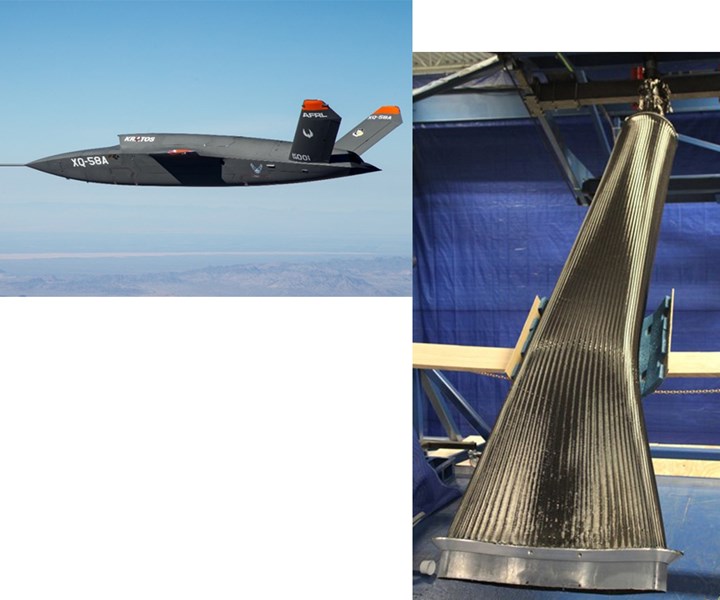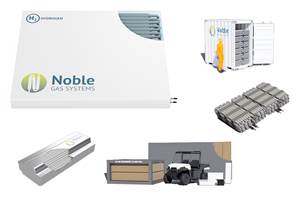AFRL evaluates braiding, SMP tooling and VARTM for lower-cost future engine inlet ducts
U.S. Air Force and Ohio-based composites team develop new process for S-shaped aerostructure.

An 11-foot long inlet duct preform is shown prior to resin infusion, part of a U.S. Air Force Research Lab (AFRL) program to lower costs for UAS like the Kratos XQ-58 Valkyrie (shown here) designed and built by Kratos Defense & Security Solutions for the U.S. Air Force Low Cost Attritable Strike Demonstrator program, under the AFRL’s Low Cost Attritable Aircraft Technology project portfolio. SOURCE | U.S. Air Force
Part of the U.S. Air Force 2030 Science and Technology strategy includes the mass deployment of low-cost Unmanned Aerial Systems to assist in future engagements. To realize this vision, new manufacturing strategies must be identified which can support the rapid manufacturing of high-quality aerospace components at lower costs than what is currently available using legacy processes.
The Air Force Research Laboratory’s (AFRL, Dayton, Ohio, U.S.) Manufacturing and Industrial Technologies Division and the Ohio, U.S.-based contractor team of Cornerstone Research Group (Dayton), A&P Technology (Cincinnati) and Spintech LLC (Xenia), conducted research to quantify the benefits of replacing legacy prepreg hand layup with dry fiber braided preform and vacuum assisted resin transfer molding (VARTM) for the fabrication of an 11-foot long, S-shaped composite engine inlet duct.
Aircraft engine inlet ducts provide a constant supply of air to prevent the engine’s compressor from stalling. The inlet must create as little drag as possible. The smallest gap in airflow supply can cause major engine problems as well as significant efficiency losses. If the inlet duct is to provide sufficient air with minimum turbulence, it must be clean and flawless.
The novel manufacturing approach for the S-shaped inlet duct replaces hand layup prepreg on a multi-piece steel mandrel followed by autoclave cure with an automated overbraid process which instead applies dry fiber. The very heavy multi-piece steel mandrel is replaced with a light-weight single-piece shape-memory polymer (SMP) mandrel. The dry braided carbon fiber is the processed into a composite structure using VARTM with a low-cost epoxy resin and oven cure.
The team completed analysis of the overbraid architecture, as well as fabrication of an SMP forming tool and the SMP mandrel that serves as the tool during the preform overbraiding process. Because of the S-shaped inlet duct’s complex geometry, multiple iterations were necessary to optimize the overbraid machine settings and minimize composite material wrinkling. A total of four inlet ducts will be fabricated and legacy part cost and production time will be compared to the new design.
“We believe that the introduction of a reusable shape memory polymer mandrel together with the automated overbraid process and an oven-based VARTM composite cure will lead to significant cost and cycle time reductions,” says Craig Neslen, manufacturing lead for the Low Cost Attritable Aircraft Technology Initiative in the Manufacturing and Industrial Technologies Division at AFRL. “Quantifying the manufacturing benefits and validating structural integrity will be critical to establishing a positive business case and convincing designers and manufacturers that the new materials and processes should be incorporated into future low-cost engine inlet duct designs.”
The final inlet duct will be delivered to the U.S. Air Force for further integration into the complementary airframe design and manufacturing program within AFRL’s Aerospace Systems Directorate. The Aerospace Vehicles Division will conduct static ground testing of the integrated braided fuselage and inlet duct structure.
“While we have yet to define all of the implications of attrition tolerance on design criteria and the resulting manufacturing materials and processes utilized, we do have a baseline with threshold requirements for strength and stiffness which we will assess via full-scale airframe ground tests,” said Ray Fisher, aerospace engineer in the Aerospace Vehicles Division.
AFRL is the primary scientific research and development center for the U.S. Air Force. It plays an integral role in leading the discovery, development, and integration of affordable warfighting technologies for our air, space, and cyberspace forces. With a workforce of more than 11,000 across nine technology areas and 40 other operations across the globe, AFRL provides a diverse portfolio of science and technology ranging from fundamental to advanced research and technology development. For more information, visit: www.afresearchlab.com.
Related Content
Noble Gas Systems 350-bar conformable pressure vessels pass HGV2 standard tests
Conformable tanks with new materials pass technical tests for hydrogen storage, to compete with Type IV pressure vessels using CFRP.
Read MoreRead Next
CW’s 2024 Top Shops survey offers new approach to benchmarking
Respondents that complete the survey by April 30, 2024, have the chance to be recognized as an honoree.
Read MoreFrom the CW Archives: The tale of the thermoplastic cryotank
In 2006, guest columnist Bob Hartunian related the story of his efforts two decades prior, while at McDonnell Douglas, to develop a thermoplastic composite crytank for hydrogen storage. He learned a lot of lessons.
Read MoreComposites end markets: Energy (2024)
Composites are used widely in oil/gas, wind and other renewable energy applications. Despite market challenges, growth potential and innovation for composites continue.
Read More























